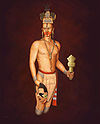- Маундвиль
-
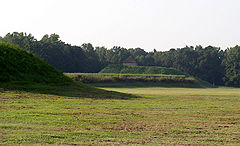 Вид через центральную площадку с кургана J на курган B, в центре — курган A.
Вид через центральную площадку с кургана J на курган B, в центре — курган A.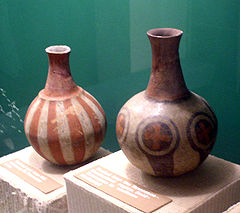 Керамика, найденная в Маундвиле
Керамика, найденная в Маундвиле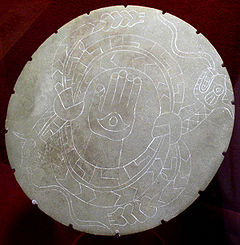 Каменная плитка с гравировкой из Маундвиля, на которой изображён рогатый змей, возможно, Великий змей — персонаж Юго-восточного церемониального комплекса (см. толкование иконографии в соответствующей статье)
Каменная плитка с гравировкой из Маундвиля, на которой изображён рогатый змей, возможно, Великий змей — персонаж Юго-восточного церемониального комплекса (см. толкование иконографии в соответствующей статье)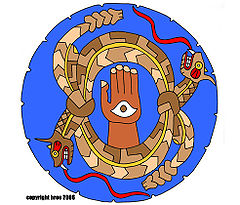 Тот же Рогатый змей — цветной рисунок индеаниста Эронимуса Рау (Heironymous Rowe) на основе вышеприведенного каменного изображения
Тот же Рогатый змей — цветной рисунок индеаниста Эронимуса Рау (Heironymous Rowe) на основе вышеприведенного каменного изображенияАрхеологический парк Маундвиль[1] — памятник миссисипской культуры на реке Блэк-Уорриор в округе Хэйл, штат Алабама, около города Маундвиль. Масштабные археологические исследования показали, что данное место представляло собой политический и церемониальный центр регионального вождества миссисипской культуры в период 11-14 веков н. э. The archaeological park portion of the site is administered by the University of Alabama Museums and encompasses Шаблон:Convert, consisting of 32 platform mounds around a rectangular [1] Moundville is the second largest site of the classic Middle Mississippian era (after Cahokia in Illinois), which covered the central Mississippi River Valley, the lower Ohio River Valley, most of the Mid-South area, and includes Kentucky, Tennessee, Alabama, and Mississippi as the core of the classic Mississippian culture area.[2] The park contains a museum and an archaeological laboratory. It was declared a National Historic Landmark in 1964 and was added to the National Register of Historic Places in 1966.
Содержание
Место
Место было заселено индейцами миссисипской культуры в период 1000—1450 гг.[1] The community took the form of a Шаблон:Convert residential and political area protected on three sides by a bastioned wooden palisade wall with the remaining side protected by the river bluff.[1] The largest platform mounds are located on the northern edge of the plaza and become increasingly smaller going either clockwise or counter clockwise around the plaza to the south. Scholars theorize that the highest-ranking clans occupied the large northern mounds with the smaller mounds supporting buildings used for residences, mortuary, and other purposes.[1] Of the two largest mounds in the group, Mound A occupies a central position in the great plaza, and Mound B lies just to the north, a steep Шаблон:Convert tall pyramidal mound with two access ramps.[1] This community plan has been interpreted as a sociogram, an architectural depiction of a social order based on ranked clans. According to this model the Moundville community was segmented into a variety of different clan precincts, the ranked position of which was represented in the size and arrangement of paired earthen mounds around the central [1] This signaled the beginning of a decline and by 1500 most of the entire area was abandoned.[1]
Население
The surrounding area appears to have been heavily populated but contained relatively few mounds before the creation of the public architecture of the plaza and mounds about 1200 AD.[1] At its height, the population is estimated to have been around 1000 people within the walls and with 10,000 additional people in the surrounding countryside.[1] Based on findings during excavations, the residents of the site were skilled in agriculture, especially the cultivation of maize.[1] Extensive amounts of imported luxury goods such as copper, mica, galena, and marine shell have been excavated from the site.[1] The site is renowned by scholars for the artistic excellence displayed by the artifacts of pottery, stonework, and embossed copper left by the former residents.[1]
Раскопки
The first major excavations were done in 1905-06 by Clarence Bloomfield Moore, it was his work that first brought the site national attention and contributed to the understanding of the Southeastern Ceremonial Complex.[3] One of his many discoveries was a finely carved diorite bowl depicting a crested wood duck. That bowl is now in the George Gustav Heye Center branch of the National Museum of the American Indian in New York City.[3] It was his removal of this and many other of the site’s finest artifacts that prompted the Alabama Legislature to bar any further artifacts from leaving the state. He was also criticized by professionals over his relatively crude excavation techniques.[3] The first large-scale scientific excavations of the site were done beginning in 1929 by Walter B. Jones, director of the Alabama Museum of Natural History and archaeologist David L. DeJarnette.[4] Current work continues to be done by Dr. Jim Knight, Curator of Southeastern Archaeology at the University of Alabama. He is currently conducting field research at Moundville with an emphasis on ethnohistorical reconstruction.[5]
External links
Bibliography
- Knight, Vernon James, Jr. 2004 Characterizing Elite Midden Mounds at Moundville. American Antiquity 69(1):304-321.
- Knight, Vernon James, Jr. 1998 Moundville as a Diagrammatic Ceremonial Center. In Archaeology of the Moundville Chiefdom, edited by V.J. Knight Jr. and V.P. Steponaitis, pp. 44-62. Smithsonian Institution Press, Washington.
- Steponaitis, Vincas P. 1983 Ceramics, Chronology, and Community Patterns: An Archaeological Study at Moundville. Academic Press, New York.
- Welch, Paul D. 1991 Moundville’s Economy. University of Alabama Press, Tuscaloosa.
- Welch, Paul D., and C. Margaret Scarry. 1995 Status-related Variation in Foodways in the Moundville Chiefdom. American Antiquity 60:397-419.
- Wilson, Gregory D. 2008 The Archaeology of Everyday Life at Early Moundville. University of Alabama Press, Tuscaloosa.
Примечания
- ↑ 1 2 3 4 5 6 7 8 9 10 11 12 13 "An Archaeological Sketch of Moundville". "Moundville Archaeological Museum". Проверено 4 декабря 2007.
- ↑ "Southeastern Prehistory: Mississippian and Late Prehistoric Period". "National Park Service". Проверено 4 декабря 2007.
- ↑ 1 2 3 "Moundville: A Breathtaking Archaeological Find in Alabama". "Laura Lee News". Проверено 13 декабря 2007.
- ↑ "HistoricalStatement". "University of Alabama: Office of Archaeological Research". Проверено 4 декабря 2007.
- ↑ "Vernon J. Knight". "Department of Anthropology". Проверено 13 декабря 2007.
Wikimedia Foundation. 2010.

